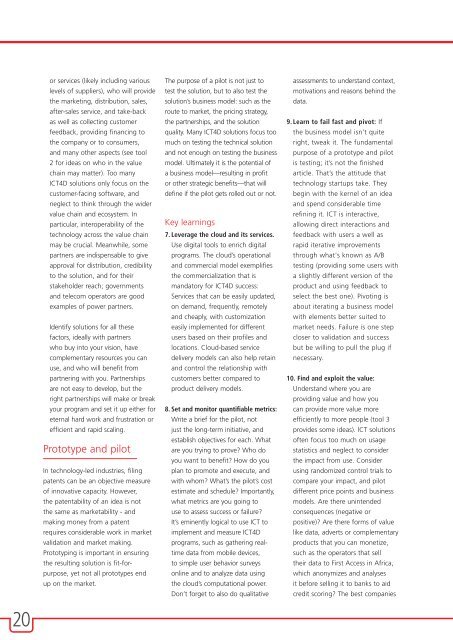Digital Enablement
1ZoIvug
1ZoIvug
You also want an ePaper? Increase the reach of your titles
YUMPU automatically turns print PDFs into web optimized ePapers that Google loves.
or services (likely including various<br />
levels of suppliers), who will provide<br />
the marketing, distribution, sales,<br />
after-sales service, and take-back<br />
as well as collecting customer<br />
feedback, providing financing to<br />
the company or to consumers,<br />
and many other aspects (see tool<br />
2 for ideas on who in the value<br />
chain may matter). Too many<br />
ICT4D solutions only focus on the<br />
customer-facing software, and<br />
neglect to think through the wider<br />
value chain and ecosystem. In<br />
particular, interoperability of the<br />
technology across the value chain<br />
may be crucial. Meanwhile, some<br />
partners are indispensable to give<br />
approval for distribution, credibility<br />
to the solution, and for their<br />
stakeholder reach; governments<br />
and telecom operators are good<br />
examples of power partners.<br />
Identify solutions for all these<br />
factors, ideally with partners<br />
who buy into your vision, have<br />
complementary resources you can<br />
use, and who will benefit from<br />
partnering with you. Partnerships<br />
are not easy to develop, but the<br />
right partnerships will make or break<br />
your program and set it up either for<br />
eternal hard work and frustration or<br />
efficient and rapid scaling.<br />
Prototype and pilot<br />
In technology-led industries, filing<br />
patents can be an objective measure<br />
of innovative capacity. However,<br />
the patentability of an idea is not<br />
the same as marketability - and<br />
making money from a patent<br />
requires considerable work in market<br />
validation and market making.<br />
Prototyping is important in ensuring<br />
the resulting solution is fit-forpurpose,<br />
yet not all prototypes end<br />
up on the market.<br />
The purpose of a pilot is not just to<br />
test the solution, but to also test the<br />
solution’s business model: such as the<br />
route to market, the pricing strategy,<br />
the partnerships, and the solution<br />
quality. Many ICT4D solutions focus too<br />
much on testing the technical solution<br />
and not enough on testing the business<br />
model. Ultimately it is the potential of<br />
a business model—resulting in profit<br />
or other strategic benefits—that will<br />
define if the pilot gets rolled out or not.<br />
Key learnings<br />
7. Leverage the cloud and its services.<br />
Use digital tools to enrich digital<br />
programs. The cloud’s operational<br />
and commercial model exemplifies<br />
the commercialization that is<br />
mandatory for ICT4D success:<br />
Services that can be easily updated,<br />
on demand, frequently, remotely<br />
and cheaply, with customization<br />
easily implemented for different<br />
users based on their profiles and<br />
locations. Cloud-based service<br />
delivery models can also help retain<br />
and control the relationship with<br />
customers better compared to<br />
product delivery models.<br />
8. Set and monitor quantifiable metrics:<br />
Write a brief for the pilot, not<br />
just the long-term initiative, and<br />
establish objectives for each. What<br />
are you trying to prove? Who do<br />
you want to benefit? How do you<br />
plan to promote and execute, and<br />
with whom? What’s the pilot’s cost<br />
estimate and schedule? Importantly,<br />
what metrics are you going to<br />
use to assess success or failure?<br />
It’s eminently logical to use ICT to<br />
implement and measure ICT4D<br />
programs, such as gathering realtime<br />
data from mobile devices,<br />
to simple user behavior surveys<br />
online and to analyze data using<br />
the cloud’s computational power.<br />
Don’t forget to also do qualitative<br />
assessments to understand context,<br />
motivations and reasons behind the<br />
data.<br />
9. Learn to fail fast and pivot: If<br />
the business model isn’t quite<br />
right, tweak it. The fundamental<br />
purpose of a prototype and pilot<br />
is testing; it’s not the finished<br />
article. That’s the attitude that<br />
technology startups take. They<br />
begin with the kernel of an idea<br />
and spend considerable time<br />
refining it. ICT is interactive,<br />
allowing direct interactions and<br />
feedback with users a well as<br />
rapid iterative improvements<br />
through what's known as A/B<br />
testing (providing some users with<br />
a slightly different version of the<br />
product and using feedback to<br />
select the best one). Pivoting is<br />
about iterating a business model<br />
with elements better suited to<br />
market needs. Failure is one step<br />
closer to validation and success<br />
but be willing to pull the plug if<br />
necessary.<br />
10. Find and exploit the value:<br />
Understand where you are<br />
providing value and how you<br />
can provide more value more<br />
efficiently to more people (tool 3<br />
provides some ideas). ICT solutions<br />
often focus too much on usage<br />
statistics and neglect to consider<br />
the impact from use. Consider<br />
using randomized control trials to<br />
compare your impact, and pilot<br />
different price points and business<br />
models. Are there unintended<br />
consequences (negative or<br />
positive)? Are there forms of value<br />
like data, adverts or complementary<br />
products that you can monetize,<br />
such as the operators that sell<br />
their data to First Access in Africa,<br />
which anonymizes and analyses<br />
it before selling it to banks to aid<br />
credit scoring? The best companies<br />
20




